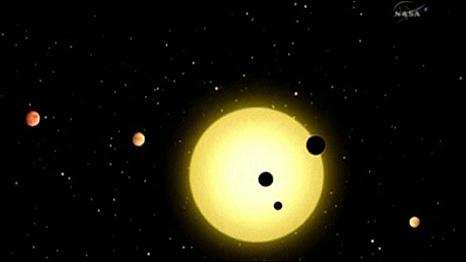媒体英语
Six New Planets 科学家发现6颗行星
By Neil Bowdler, BBC News

Kepler measures stars' "light curves" as planets block some of their light
媒体英语会带大家一起学习BBC撰稿人在报道世界大事时常用到的单词和短语。
Background:科学家近日通过“开普勒”太空望远镜观测到一个距离地球2000光年的奇特行星系统。其恒星与太阳相似,并有6颗行星围绕它运行。
收听与下载
Finding six new planets around a single star represents an impressive haul. Nasa is calling it the best find since the first so-called ‘exoplanet’ was discovered 16 years ago. It might not be the most populated solar system yet found - six or possibly seven planets have been found in a rival system, but it's the nature of this new discovery which is getting the astronomers scratching their heads in wonder.
Five of the six planets are crammed tightly in around the Kepler-11 star, with orbits of between just ten and 47 days. That means they're all super hot, but the data suggests they're also made mostly of gas.
That's strange, because small hot planets this close in should have been ripped asunder by their parent star in their formative years, say the scientists. One possible explanation is that the planets started out bigger and further out and were slowly dragged into tighter orbits, as part of a contracting belt of dust and asteroids.
Glossary 词汇表 (收听发音, 请单击英语单词)
- impressive奇特的,轰动的
- haul(一次发现的)数量
- so-called所谓的
- exoplanet外星球
- to scratch (one’s) head感到不解
- to cram 挤在(狭小的轨道空间内)
- orbit 轨道
- to rip asunder 炸成碎片
- formative years 形成期
- to drag 拖入
- to contract 收缩
- asteroid 小行星

